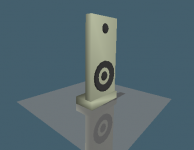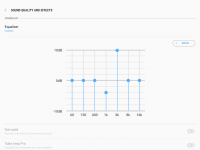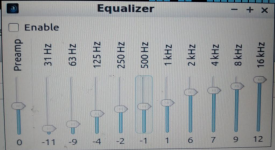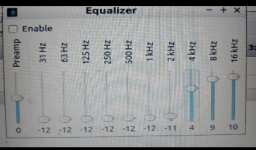After building and using a pair of on-wall mini bookshelf speakers, I decided to tear them down and build something with better bass and accuracy.
Building a set of mini on-wall speakers in wood was on the cards, but with one bad experience with a bookshelf speaker that turned out too shallow, I decided it was not worth the risk and effort at this point, maybe later. I also was set on using existing speakers instead of buying new ones - Fostex and so on, lets see what I can do.
Initial experiments consisted of using the existing Realistic 1011 or so woofers, and the unknown NS speakers that I purchased at the local electronics store for less than $6 a pair. Of course there will be the opportunity to spend later if I see the need to.
Initial testing with the TEA2025 PC speaker amplifier and a software equalizer revealed that the Realistic could output suffcient bass, but output volumes were very low. On the other hand the NS speakers sounded good enough, with a coil hacked from a crossover I bought many years ago, seemed adequate for the purpose: my only alternative now for desktop or in-room music is the mono Bluetooth speakers that I am now somewhat tired of.
A cardboard prototype showed some interesting results - the speakers were best about 60 cm from the wall, and lifting the speakers 30 cm above the desk improved the sound and made the distorted ringing sounds from the desktop disappear. So reflections are a factor after all!
Now all that remains is to build the baffles and fit the speakers, and find a sufficient coil for the crossovers.
Building a set of mini on-wall speakers in wood was on the cards, but with one bad experience with a bookshelf speaker that turned out too shallow, I decided it was not worth the risk and effort at this point, maybe later. I also was set on using existing speakers instead of buying new ones - Fostex and so on, lets see what I can do.
Initial experiments consisted of using the existing Realistic 1011 or so woofers, and the unknown NS speakers that I purchased at the local electronics store for less than $6 a pair. Of course there will be the opportunity to spend later if I see the need to.
Initial testing with the TEA2025 PC speaker amplifier and a software equalizer revealed that the Realistic could output suffcient bass, but output volumes were very low. On the other hand the NS speakers sounded good enough, with a coil hacked from a crossover I bought many years ago, seemed adequate for the purpose: my only alternative now for desktop or in-room music is the mono Bluetooth speakers that I am now somewhat tired of.
A cardboard prototype showed some interesting results - the speakers were best about 60 cm from the wall, and lifting the speakers 30 cm above the desk improved the sound and made the distorted ringing sounds from the desktop disappear. So reflections are a factor after all!
Now all that remains is to build the baffles and fit the speakers, and find a sufficient coil for the crossovers.
Finding the resonant frequencies of the drivers
Initial testing of both speakers, the Realistic and the NS speaker using an online tone generator and some confetti on the speaker cone revealed the resonance frequency of these speakers.
Realistic 40-1011A 8 Ohm 6 inch speaker : 50 Hz
Rocky NSP-5-1 5 inch "woofer" : 170 Hz
The Realistic can output nice bass but needs some power to drive it. If the line input is a CD player or a laptop it may be sufficient, but at the moment I really need to run these off phone and tabs.
So the NSP-5-1 looks like it. Using a coil from an old crossover resulted in a cleaner sound, but nothing like low bass. Sound is pleasing enough.
Pictured are the rear panel of both speakers and a screenshot of the tone generator. The bits of paper were really dancing about at the resonant frequencies - thanks to a suggestion from an audio book.
Initial testing of both speakers, the Realistic and the NS speaker using an online tone generator and some confetti on the speaker cone revealed the resonance frequency of these speakers.
Realistic 40-1011A 8 Ohm 6 inch speaker : 50 Hz
Rocky NSP-5-1 5 inch "woofer" : 170 Hz
The Realistic can output nice bass but needs some power to drive it. If the line input is a CD player or a laptop it may be sufficient, but at the moment I really need to run these off phone and tabs.
So the NSP-5-1 looks like it. Using a coil from an old crossover resulted in a cleaner sound, but nothing like low bass. Sound is pleasing enough.
Pictured are the rear panel of both speakers and a screenshot of the tone generator. The bits of paper were really dancing about at the resonant frequencies - thanks to a suggestion from an audio book.
Attachments
Last edited:
Becoming a crossover artist
For the crossover, there are some nice sites that let you calculate the crossover for this setup. First, of course, I will run pink noise through the speakers - woofer and tweeter - and analyse the frequency sensitivity to then plan the crossover. An external Microphone + Audacity on a laptop should do it. Will need to calibrate that system though.
This crossover calculator site gives the following values for a 4000Hz crossover:
1st Order Butterworth
4000 Hertz
4 Ohm Tweeter / 4 Ohm Woofer
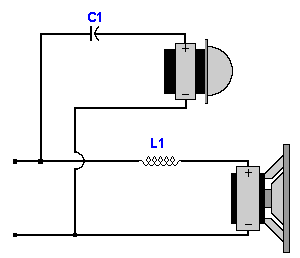 Parts List
Parts List
Capacitors
C1 = 9.94 uF
Inductors
L1 = 0.16 mH
And this site helps to find the wire length needed for the coil based on radius and wire gauge.
Inductor Calculator
Inductance 0.16 mH
DC Resistance 0.67 Ohms
Wire Gauge24 AWG
Wire Diameter 20.1 mils (1 mil = .001 in)
Coil Length 1 in
Coil Inner Diameter 1 in
Coil Outer Diameter 1.08 in
Average Turn Diameter 1.02 in
Wire Length 25.61 feet
Copper Weight 0.03 pounds
Turns 96
Levels 1.93
Turns/Level 49.75
Would appreciate it if someone could give me a reality check
For the crossover, there are some nice sites that let you calculate the crossover for this setup. First, of course, I will run pink noise through the speakers - woofer and tweeter - and analyse the frequency sensitivity to then plan the crossover. An external Microphone + Audacity on a laptop should do it. Will need to calibrate that system though.
This crossover calculator site gives the following values for a 4000Hz crossover:
1st Order Butterworth
4000 Hertz
4 Ohm Tweeter / 4 Ohm Woofer

Capacitors
C1 = 9.94 uF
Inductors
L1 = 0.16 mH
And this site helps to find the wire length needed for the coil based on radius and wire gauge.
Inductor Calculator
Inductance 0.16 mH
DC Resistance 0.67 Ohms
Wire Gauge24 AWG
Wire Diameter 20.1 mils (1 mil = .001 in)
Coil Length 1 in
Coil Inner Diameter 1 in
Coil Outer Diameter 1.08 in
Average Turn Diameter 1.02 in
Wire Length 25.61 feet
Copper Weight 0.03 pounds
Turns 96
Levels 1.93
Turns/Level 49.75
Would appreciate it if someone could give me a reality check
Last edited:
Some 3D modelling (Wings 3D) to sort out the aesthetics. The baffle is raised above the desk surface to avoid unpleasant interactions with the desktop as seen in this simulation.
Last edited by a moderator:
That method is great when you have the image location. When you have the image itself you need to attach it to your post or you get the empty boxesWow! you can just cut and paste images into this forum. Amazing.
How to attach images to your posts.
Attachments
Last edited:
Used this way, it might need to be larger. Your driver impedance will be greater than 8 ohms at the higher end. It continues to rise. It would be more predictable if you attend to the impedance rise. This would take another 2 components. Otherwise you could try using a larger inductor.
3D Design view and progress
Just made the cutout for the 'woofer', I was not sure my equipment was upto it. 4 mm plywood. I am mounting the speaker behind the board as it is easier to attach, despite diffractions from the edges of the cutout.
Really need to get this up and running, so much good music out there.
3D Image of design show. (Wings 3D: 20 minutes)
Just made the cutout for the 'woofer', I was not sure my equipment was upto it. 4 mm plywood. I am mounting the speaker behind the board as it is easier to attach, despite diffractions from the edges of the cutout.
Really need to get this up and running, so much good music out there.
3D Image of design show. (Wings 3D: 20 minutes)
Attachments
How important is bass and is it OK to compromise
Thanks Allen
I listened to the OB speaker again last night and did some tests. I listened to this track "I Keep Forgetting"
Michael McDonald - I Keep Forgettin' (Every Time You're Near) (Official Audio) - YouTube
and it sounded fine, along with some other High Definition tracks transferred from CD. I enjoy listening to the speaker, although it is not doing justice to the recording.The bass in nowhere near as powerful as in my car system, but the clarity and punch of the speaker itself is sufficient for me to get on listening to music and forgetting the equipment for a while.
Should I do this? I may add a sub-woofer later on if I can design it, but with the TEA 2025 and its 2 watts I do not have much power.
It is a philosophical question really, should I compromise the goal of HiFi, at least for the moment?
For reference here are my amp specs.
TEA 2025
3V < VCC< 15
VP=2•1W,
VCC= 6V, RL=4ΩP=2•2.3W,
VCC= 9V, RL=4ΩP=2•0.1W,
VCC= 3V, RL=4Ω
TEA2025 pdf, TEA2025 description, TEA2025 datasheets, TEA2025 view ::: ALLDATASHEET :::
Thanks Allen
I listened to the OB speaker again last night and did some tests. I listened to this track "I Keep Forgetting"
Michael McDonald - I Keep Forgettin' (Every Time You're Near) (Official Audio) - YouTube
and it sounded fine, along with some other High Definition tracks transferred from CD. I enjoy listening to the speaker, although it is not doing justice to the recording.The bass in nowhere near as powerful as in my car system, but the clarity and punch of the speaker itself is sufficient for me to get on listening to music and forgetting the equipment for a while.
Should I do this? I may add a sub-woofer later on if I can design it, but with the TEA 2025 and its 2 watts I do not have much power.
It is a philosophical question really, should I compromise the goal of HiFi, at least for the moment?
For reference here are my amp specs.
TEA 2025
3V < VCC< 15
VP=2•1W,
VCC= 6V, RL=4ΩP=2•2.3W,
VCC= 9V, RL=4ΩP=2•0.1W,
VCC= 3V, RL=4Ω
TEA2025 pdf, TEA2025 description, TEA2025 datasheets, TEA2025 view ::: ALLDATASHEET :::
Last edited:
Testing frequency ranges
My Tab has a music app with an equalizer, which I used to do some testing of frequency ranges for the speaker in designing the crossover.
This is where experimenting, even with small speakers really makes for a great learning experience.
I played my usual selection of songs through the equalizer with the woofer and tweeter connected separately in turn. What I found was somewhat unsettling - I should have known this before, but there it was.
With the woofer, boosting the frequencies at 3 Khz resulted in some distortion at the highest level of boost. Below this level there was no distortion except at the very lowest levels.
The tweeter also generated some distortion when the 3 Khz was boosted. So it appears that in order to avoid distortion, which I do not like, at least distortion at high volume levels, I have to run the amplifier output through a crossover that reduces these frequencies. This may create a low in the speaker response overall. So : low distortion or flatter frequency response? I prefer to go with lower distortion and try to put up with the lack of response.
My Tab has a music app with an equalizer, which I used to do some testing of frequency ranges for the speaker in designing the crossover.
This is where experimenting, even with small speakers really makes for a great learning experience.
I played my usual selection of songs through the equalizer with the woofer and tweeter connected separately in turn. What I found was somewhat unsettling - I should have known this before, but there it was.
With the woofer, boosting the frequencies at 3 Khz resulted in some distortion at the highest level of boost. Below this level there was no distortion except at the very lowest levels.
The tweeter also generated some distortion when the 3 Khz was boosted. So it appears that in order to avoid distortion, which I do not like, at least distortion at high volume levels, I have to run the amplifier output through a crossover that reduces these frequencies. This may create a low in the speaker response overall. So : low distortion or flatter frequency response? I prefer to go with lower distortion and try to put up with the lack of response.
It's good that you are enjoying them, that counts.
Are you clear on the reason that OB is working for you at the moment? That isn't an easy question to answer because there are multiple factors. The closed box comes from a different place. It can be made to work, I think it is more to do with how you do it.
Are you clear on the reason that OB is working for you at the moment? That isn't an easy question to answer because there are multiple factors. The closed box comes from a different place. It can be made to work, I think it is more to do with how you do it.
Equalizer testing and the OB
Picture of Tab One equalizer : Samsung Music. This is the app I used to push up the frequencies and check its effect on the speaker, very revealing. As I remember, 8 K and above was fine for the tweeter, and 400 Hz and below was good for the woofer: no distortion.
This video helps a little bit:
2 Way vs 3 Way - YouTube
About open baffle: right now there are three main advantages
1) Quick and easy to build
2) Takes up less desk space
3) Lower risk of failure
The third point bears elaborating - I know how it sounds, I got two speaker boxes built for the 6 1/2 inch Realistic and it turns out the box was not deep enough. Waste of time.
Picture of Tab One equalizer : Samsung Music. This is the app I used to push up the frequencies and check its effect on the speaker, very revealing. As I remember, 8 K and above was fine for the tweeter, and 400 Hz and below was good for the woofer: no distortion.
This video helps a little bit:
2 Way vs 3 Way - YouTube
About open baffle: right now there are three main advantages
1) Quick and easy to build
2) Takes up less desk space
3) Lower risk of failure
The third point bears elaborating - I know how it sounds, I got two speaker boxes built for the 6 1/2 inch Realistic and it turns out the box was not deep enough. Waste of time.
Attachments
OB works
Well yes, frequency spread counts and that can be checked with a pink noise generator. The other thing is accuracy.
The OB is better than the corrugated cardboard multi pole radiator that I built some time ago - with a port no less.
Further testing awaits.
It's good that you are enjoying them, that counts.
Are you clear on the reason that OB is working for you at the moment? ....
Well yes, frequency spread counts and that can be checked with a pink noise generator. The other thing is accuracy.
The OB is better than the corrugated cardboard multi pole radiator that I built some time ago - with a port no less.
Further testing awaits.
Testing with a Laptop equalizer - Audacious
After the system to a laptop output, I played some pink noise and boosted each band of the equalizer to find out which frequencies were produced by the woofer and tweeter.
The images you are about to see are not those equalizer settings but a representation of the relative loudness of the each of the frequencies for each speaker. In other words I used the equalizer as a graphing tool.
For the woofer (image on the left), pink noise low frequencies below 63Hz and 33Hz were audible but very soft. Turning up the volume of boosting these frequencies may enhance the bass, however it may lead to distortion and reduced the sound volume overall.
For the tweeter (image on the right), anything below 2 kHz was not producible, which mandates a high cut off at 2 kHz or higher depending again on the level of distortion I can tolerate with real music. The tweeter was connected without any capacitors in line. The tweeter also plays a little loud, so I need a resistor in the circuit as well.
After the system to a laptop output, I played some pink noise and boosted each band of the equalizer to find out which frequencies were produced by the woofer and tweeter.
The images you are about to see are not those equalizer settings but a representation of the relative loudness of the each of the frequencies for each speaker. In other words I used the equalizer as a graphing tool.
For the woofer (image on the left), pink noise low frequencies below 63Hz and 33Hz were audible but very soft. Turning up the volume of boosting these frequencies may enhance the bass, however it may lead to distortion and reduced the sound volume overall.
For the tweeter (image on the right), anything below 2 kHz was not producible, which mandates a high cut off at 2 kHz or higher depending again on the level of distortion I can tolerate with real music. The tweeter was connected without any capacitors in line. The tweeter also plays a little loud, so I need a resistor in the circuit as well.
Attachments
Last edited:
- Status
- This old topic is closed. If you want to reopen this topic, contact a moderator using the "Report Post" button.
- Home
- Loudspeakers
- Multi-Way
- Desktop Open Baffle Speaker System Project
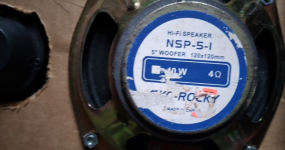
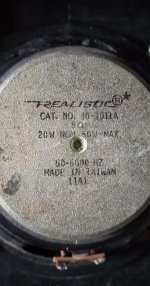
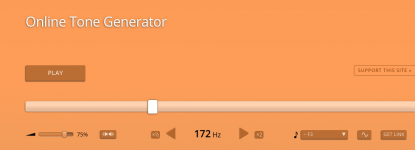
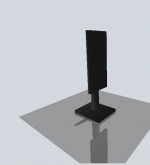
 removed malformed image links
removed malformed image links 